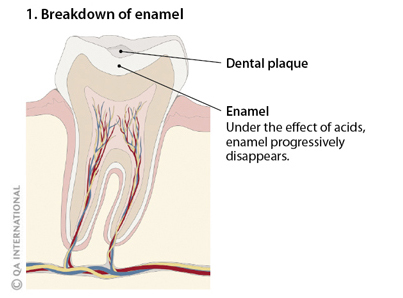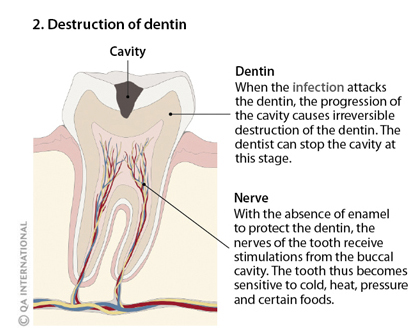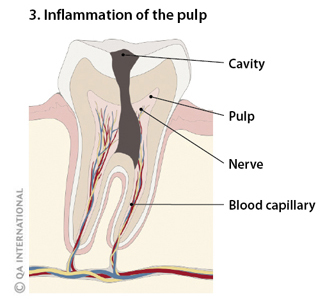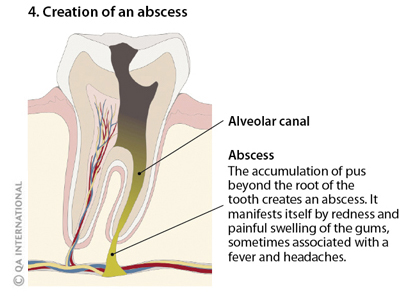
Cavities: when sugar attacks teeth
Bacteria present in the dental plaque can proliferate, nourished by the sugars coming from food. While developing, they progressively destroy the different hard tissues of the tooth, forming a cavity. The significant or frequent consumption of sugar, poor oral hygiene, and the insufficient production of saliva promotes the formation of cavities. In the absence of treatment, a cavity can develop into an abscess.
How cavities form |
 |
The bacteria in the dental plaque transform the sugars from food into acids, which dissolve the enamel layer of the tooth. |
 |
The breakdown of the enamel creates a breach by which bacteria penetrate the tooth. The infection spreads to the dentin and destroys it. |
 |
The infection attacks the heavily innervated pulp and causes its inflammation. The pain is therefore intense and continuous. |
 |
In the absence of treatment, the infection spreads to the alveolar canal. It can lead to necrosis of the tooth and form an abscess. The infection can spread to the entire body and cause serious complications, like meningitis, endocarditis, and joint infections. |
Dental X-rays
Rapid and painless, dental X-rays make visible the hard tissues of the tooth as well as any prior treatment to establish the diagnosis of a tooth or gum affliction.
Treatment of a cavity
Drilling is the first step in treating a cavity. It consists in eliminating all of the infected tissues of the tooth with a metal drill. The cavity created is then filled with a resistant and nontoxic material, which may be an amalgam filling or composite resin. The dentist molds the filling material while respecting the shape of the tooth and then polishes it, which restores the aspect of the tooth and its function of chewing food. A treated tooth is more fragile and must be monitored carefully because new cavities can form under an old filling. When the cavity is deep, a root canal and placement of an artificial crown may be necessary.
Root canal
In the case of deep cavities, dental abscesses, or even a broken tooth, a root canal (devitalization or pulp removal) may be completed under local anesthesia. After having removed all of the pulp from the tooth, the alveolar canals are cleaned, widened, disinfected, and filled with a filling material. The upper part of the tooth is filled with an amalgam filling or composite resin. Deprived of pulp, the tooth is no longer irrigated by blood vessels and becomes more fragile. When the natural crown is very damaged, a root canal is often followed by the placement of an artificial crown. The entire treatment is painless, but it is a long and meticulous process that may be divided into multiple sessions.

Oral health
|

|
|
Have your teeth axamined regularly by a dentist
Depending on the individual, annual or semiannual cleanings and exams at a dental clinic prevent the development of cavities and tartar accumulation.
Avoid smoking
The active consumption of tobacco promotes the development of cavities, periodontitis, and mouth cancer.
Take care of your childrens health
- To avoid the appearance of cavities, limit your children’s consumption of sugary foods, particularly before bed. Also avoid giving them a bottle of milk or fruit juice just before they fall asleep.
- Your child's first teeth can be wiped with a damp cloth. Later on, use a small soft children's toothbrush and toothpaste your childs teeth twice a day. Progressively teach your child to do it himself.
- Take your child to the dentist after the eruption of his first tooth and regularly thereafter.
- To prevent misalignment of the teeth, discourage prolonged thumb sucking.
Also see:
In the Visual Dictionary:
- "Teeth" section
In the encyclopedic capsules :




